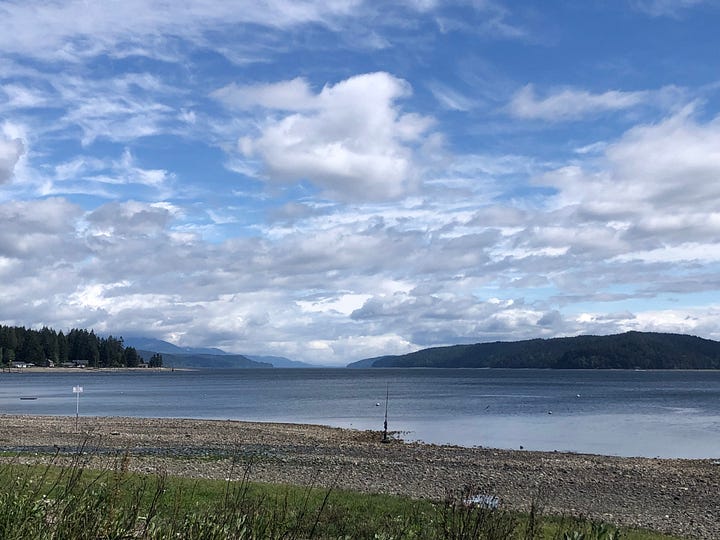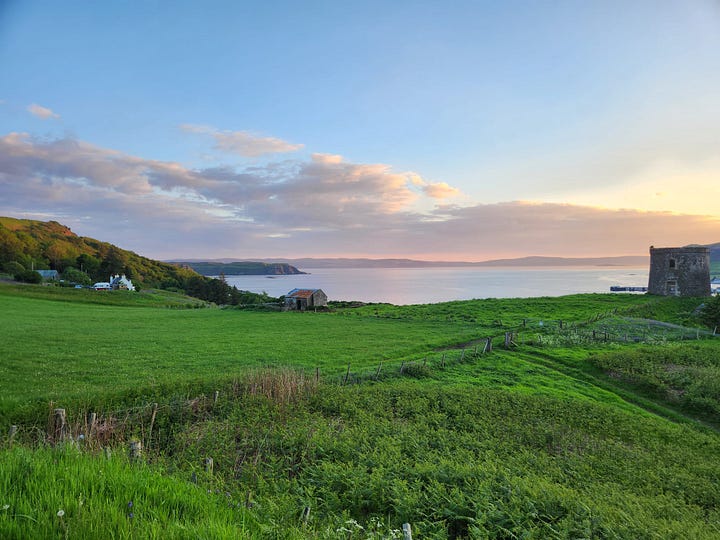Notes from Outside
moonlighting as a seneschal


There’s a commune of wasps building a nest in the greenhouse. Before she left on a trip without me, my wife asked me to take care of them. I told her I would.
They’re paper wasps, the most peaceable of their kind. They’re gentler even than bumblebees, with a code of conduct: They strike dramatic warning stances long before they decide to sting you. They chew up plant matter and mix it with their saliva, then construct mathematically perfect paper nests out of it, clusters of long hexagonal tubes spiraling out in Fibonacci sequence.
Earlier this year, when the danger of frost had passed, a foundress crawled out from her winter nest, the only survivor of last year’s brood, and hung the first ring of cells. She packed pieces of other insects into them and laid a single egg in each. Three weeks later wasps emerged, freshly fed, and began to make more cells, for more eggs, for more wasps.
The nest in the greenhouse was tiny when my wife left, maybe two inches across at its widest point. The wasps posted guards on the outside of it, a posse of narrow-waisted workers with wings draped down their backs.
One morning while my wife was gone, I opened the greenhouse doors and the roof vent wide and sprayed the nest with a bottle of wasp-killer. There were fewer than ten sentries attending it. They tumbled off one by one, writhing.
Two days later I came back to water the cilantro and the bean sprouts. I found the shriveled corpses still lying on the ground where they’d fallen and streaks of poison dried onto the glass. Two live wasps were standing guard on the nest, which had grown by a couple of additional chambers. They ignored me as they always did.
Last year we had ants in the greenhouse. This year we don’t. It may be because the ants took a different path this year, followed different orders, chose another way forward for their civilization. It may be because paper wasps secrete an ant-repelling hormone and mix it into the material of their nests to keep them off of the future wasps. The potted lemon tree that suffered so dreadfully from aphids last year is pest-free, too, home now only to a tiny yellow spider who’s crafted a penthouse between the two top leaves. Paper wasps, as it happens, feed aphid larvae to their offspring.
When it gets hot in the greenhouse, the sentries stand tall on their thin legs and fan their wings to cool the nest. When the heat dissipates at night they press their bodies to it to keep it warm. In late summer the foundress will die (whoever she is—wherever she is—did I assassinate her?), along with her servants, and each tube will produce a final adult wasp (unless I killed them all in their cradles, unless they’re all now living for an unviable nest). They will all die when the weather turns, and the future foundresses will hibernate. In the spring, the foundresses will build new nests by themselves and lay eggs for a new brood of workers to serve them.
The new foundress will recognize the greenhouse as a place of safety, even if I take the empty nest away after the autumn equinox. Her predecessors left their secretions all over it. The next foundress may plant the stem of the nest in the same spot, unless it reeks too much of poison now.
I was disciplined while my wife was away. Every day she was off hiking through misty crags, staring out over the gray sea, sipping peaty drinks, climbing into castles, I put thirty minutes into the Targeted Nipplewort Eradication Project (TNEP).
The old folks in the Facebook group where we discuss invasive weeds won’t type out nipplewort’s common name—they think it’s too raunchy for the Internet. They call it by its proper name, Lapsana communis. This weed, they told me, rewards a little effort. Knock it out of your yard one year and you’ll have almost none of it the next. Its roots are thin and shallow in the loose topsoil, so it pulls like a dream. In thirty minutes you can make a respectable pile of nipplewort corpses.
And I did. Every afternoon after work I set a timer and went patrolling. For a week I had as much nipplewort as I could pull at my fingertips. Time was of the essence: The entire life cycle of an invasive weed can be under two weeks. You have to get it before it sets seed, or pulling it just becomes a way to help it reproduce. I did not permit distraction. I did not pull the burgeoning willow herb, or the dandelions, or the hawkweed, or the ivy. Nipplewort only.
Nipplewort corpses can go in the yard waste bin. They are invasive, which means they spread quickly and crowd out other plants—but not noxious invasive, which means there is no need for the county government to intervene in their disposal. Digging up nipplewort revealed many front yard secrets, like a squirrel’s forgotten cache of chestnuts putting up seedlings under a rhododendron and an ancient metal spoon crowdsurfing on the English ivy.
I got to the point I half-imagined I was doing all this for my wife, somehow. My wife wouldn’t be able to pick nipplewort out of a lineup, but I came to believe it was important that she see the black dirt under the fir tree, bare of weeds, when she came home. I took on the mentality of a Rottweiler. I cased the grounds so that I could say, when she came home, that someone had been casing the grounds. Don’t worry! I wanted to assure her. Someone supervised the passing of time while you were away. There is a custodian here.
I went digging for manila clams while my wife was gone. I woke up early at my neighbors’ instruction and put a hand rake and a little cooler in a bag, along with my one-day shellfish-harvesting pass, paid for online and printed out at home. The fish cops take this kind of thing seriously in the high season—you read stories in the paper about smugglers getting pulled over with SUVs full of geoduck, abandoning their catch and fleeing into the woods. We drove out to a tiny state park on the canal and took the last two parking spots. Of course, there was more than enough waterline for everyone.
They grow oysters on the canal. Oysters also grow themselves. The law about wild oysters is that you can eat your fill, but only on the beach—none may be carried away. So people came with little tripod seats and built fires among the heaps of barnacle-thick shells and sat there with their shucking knives all day, eating massive gooey oysters plucked right from the water. The tideline was oyster detritus end-to-end. I wore hiking boots and crushed eight-inch-long white shells under every step as we tramped out half a mile to a wide, bare stretch of sand.
My wife and I had hunted razor clams together earlier in the year, out by the ocean. Our neighbors showed us how to plunge the clam gun down over a half-inch divot in the sand, seal the hole and haul up with all the power in our shoulders. The hope was to dump five pounds of wet sand and a single massive shellfish onto the beach, instead of stare down into the quickly-filling hole and watch a clam ass wriggle into the murk. We took it in turns to save each other’s backs and came home with two meals’ worth of clams.
Manila clams were better suited to solo digging. There was no need to hunt for signs of life—anywhere I scraped back a half-inch of smooth, wet sand there were piles of manila clams beneath, nestled together, waiting to be harvested. They wriggled slowly when their bedmates began to disappear around them, and never fully buried themselves before I plucked them out to measure them. I gained my daily limit of forty in less than an hour.
I didn’t know anything about shellfish before I moved next door to a couple of foragers. They taught me everything I know. Back when we hunted razor clams, I learned that clams have a beautiful organ inside of them called the crystalline style. It is a transparent rod that releases digestive enzymes while the animal feeds. In the smaller bivalves, like manila clams, we swallow them unnoticed. The bigger bivalves must have them removed. When a dead razor clam is disassembled, a little pressure in the right place ejects the style neatly from the flesh. It barely looks organic—the first time I found one I wondered if it was actually made of crystal, or silica, or plastic.
My wife left the house while I disassembled the razor clams, for fear that the sights and smells would ruin the harvest for her. While she was out I built a little stack of crystalline styles next to the cutting board because I thought they looked precious, collectible. I threw them away with the guts and shells before she got home.
The evening after I dug manila clams I cooked them in white wine broth for two friends. There were just enough for three of us. No disassembly required: They opened in the steam as they died, each with the same resigned click, as easy as taking them from the beach had been. They were tender and garlicky and delicious.
I daydreamed about going back to the same beach and plucking out forty more of their ten million brethren the next day. I could make them Belgian-style for my wife—it would be fun to eat up an evening that way, to take more time than necessary to make perfectly crispy frites and present them to her when she came in from the airport. Harvesting clams was so very much the kind of thing I wanted to be doing all the time. So simple; so scenic; so rustic! The foggy low tide in the early morning, the clear rain-washed spring sky, the endless abundance underfoot!
In the end, it turned out to be further than I was willing to stray from the house alone. When the moment was available I found I had more important things to do.

This is such a lovely essay. At first I misread “take care of” the wasp nest to mean “care for” and asked myself, Why would anybody care for wasps?
But this whole essay is about the different ways we can be “custodians” of nature. Sometimes it’s by spraying wasps and failing to eradicate them, sometimes it’s by uprooting invasive species, and sometimes it’s by joining in with a foraging community.
I’m glad your wasps survived and are protecting you from ants!
Oh, how I adore your writing.